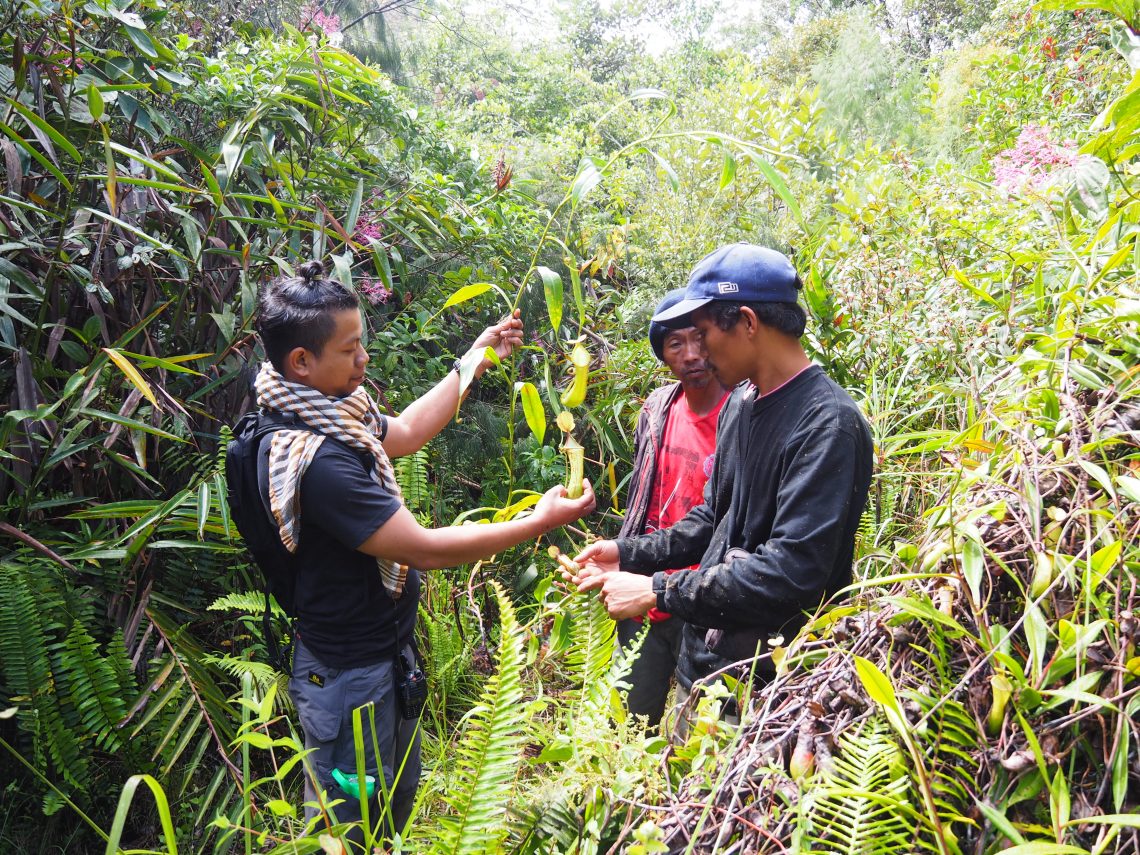
Vanessa Handley, Director of Collections & Research
This article was originally printed in the UC Botanical Garden Newsletter, Vol. 44, 2019
Tropical forests are the most biodiverse ecosystems on Earth, collectively harboring roughly 60% of the world’s species. Tragically, these cradles of biodiversity are also among the most critically imperiled. Current estimates indicate that tropical forests are being lost at the alarming rate of over 39 million acres per year worldwide. This catastrophic loss is exacerbated by recent intensification of meteorological events, causing further loss of forested areas and associated soils.
This situation is writ large in the Philippine archipelago. While the islands that comprise this nation harbor immense biodiversity, less than 10% of the original habitat remains. The biodiversity in these remnants is seldom well documented and often subject to ongoing encroachment. Scientific exploration and conservation are therefore vital, particularly in the southern Philippines.
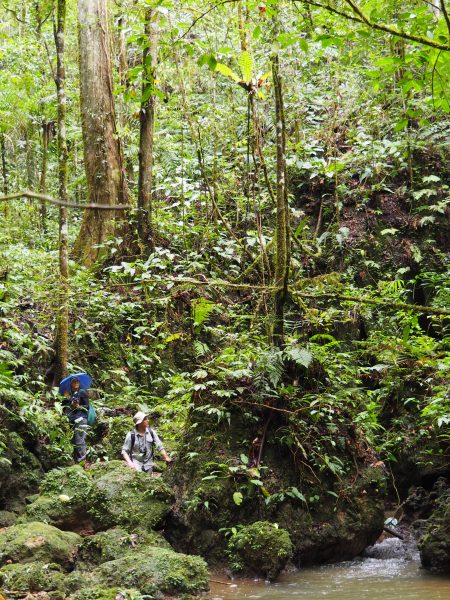
Ascending into a riparian area in Marilog Forest Reserve
To this end, an ambitious four-year botanical survey of this region was recently initiated. The project is funded by the National Science Foundation through an award made to researchers at the Botanical Research Institute of Texas (Dr. Peter Fritsch), University of North Carolina Wilmington (Dr. Darin Penneys), and Southern Illinois University (Dr. Daniel Nickrent). I was honored to be invited to participate in the project and embarked on the inaugural expedition this past June.
Our international team assembled at Central Mindanao University (CMU) in Bukidnon, Mindanao, the second largest island in the Philippines. Our hosts and in-country partners (led by Dr. Victor Amoroso and Dr. Fulgent Coritico) gave us the warmest welcome imaginable. They also organized a botanical symposium at which many of us presented (I delivered a talk on “Integrated Conservation at the UC Botanical Garden”). Researchers and students from throughout the region attended. It was wonderful to meet so many members of the scientific community in the Philippines and share our work at UCBG.
After planning meetings and final preparations (including a trip to the market to purchase the sturdy rubber boots so essential for tropical fieldwork), we headed to our first site, Marilog Forest Reserve. Once there, we broke into our designated groups, including two seed plant groups and one group each for ferns, lichens, and bryophytes. Each group was composed of senior scientists, students, and local researchers. The latter were community members with indigenous botanical knowledge and deep familiarity with the forests we would be exploring. Both kinds of expertise proved invaluable during our fieldwork.
The members of Seed Plant 2, as our group was called, quickly fell into easy camaraderie. The long days of intense work were lightened with laughter and conversation. Our collective objective was to systematically survey and document the plant diversity of the area. This required keen scouting and copious documentation via field notes and scientific photographs. Of course, we also collected specimens: materials for herbarium vouchers (pressed plant specimens) and leaflet tissue for future DNA extraction.
We’d set out early each day in anticipation of torrential downpours by late afternoon. Underneath the towering canopy, the tropical montane forest was replete with palms, tree ferns, and orchids. Interspersed were a host of showy shrubs including species of Fagraea, Matthaea, and Freycinetia. Almost immediately we began spotting members of the Melastomataceae, a family of research interest to several of us on the team, myself included. Most exciting was a grove of huge Astrocalyx calycina, an extremely rare, endemic tree species. I was also delighted to see another melastome, Melastoma malabathricum, lighting up the understory with flamboyant flowers.

The Seed Plant 2 group working on Mt. Limbawon
Given the botanical richness encountered, we often could only advance a few hundred meters before having to settle down to process a mountain of specimens. In addition to the general collecting activities, I regularly paused to collect seeds and spores for the living collections at UCBG and elsewhere.
The Marilog area had already been subject to botanical surveys so everyone was surprised by the wealth of new occurrences uncovered during this first stage of the expedition, including putative new species. We would have gladly continued collecting there but had to move on to other relatively unexplored localities on the island.
After a brief pitstop at CMU, we set off for Mt. Limbawon, an 1880 m (6100 ft) peak in the Pantaron Range. The journey itself was an adventure, with a dawn departure by van to a rendezvous point by the side of the road. This spot marked the start of a rough dirt track that could not be traversed in vehicles. Awaiting us was a fleet of motorcycles. It seemed almost everyone with a bike had been mobilized from the adjacent town. We each hopped behind a driver and set off in a long cavalcade. After a half hour of riding, we arrived at a beautiful village at the base of the mountain. Lunch and then – upwards! The climb was beautiful, but hot. I prefer to get such ascents over quickly, so forged ahead with a group of porters. Easy for me: I was only carrying my own gear. The men and women porting had giant packs of provisions, including heavy cooking pots, sacks of rice, and, most remarkably, cardboard tiers of fresh eggs. All were balanced with seeming ease up slippery mud slopes navigated in flip flops or bare feet.
Members of the local community had cleared the route to our base camp; we were grateful not to have to machete through the undergrowth. We pitched our tents and immediately started exploring. Over the next week we made transects from camp to the top of Limbawon. The unspoiled mossy forest at higher elevations was breathtaking, as were the otherworldly pitcher plants (various Nepenthes species), stilt palms, and epiphytic Ericaceae. The “bonsai forest” at the peak was speckled with pint-size Dacrydium elatum, boggy thickets of twigrush (Machaerina), and woody plants such as Rhododendron quadrasianum and Syzygium. It is also home to an intriguing disjunct population of Drosera rotundifolia, the round-leaved sundew found here in California!
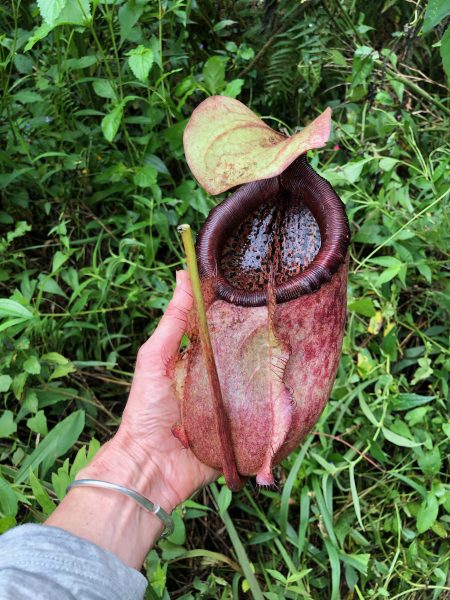
Nepenthes sp.
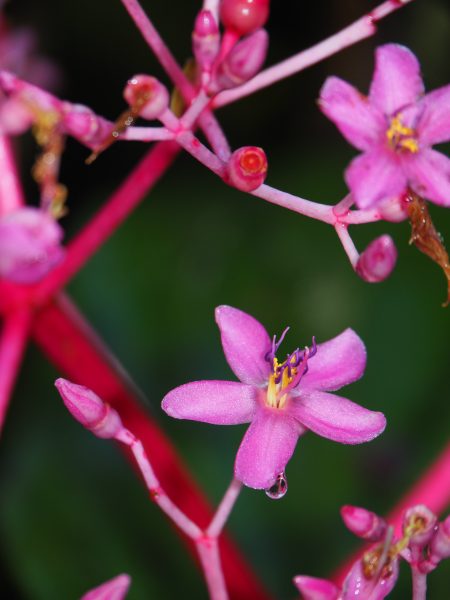
Medinilla teysmannii
Dramatic rains quickly reduced our campsite to a sea of mud and one sustained downpour transformed the meandering stream beside us into a roaring, brown river. Quick thinking by some of the community researchers, and brave maneuvering of a massive log, saved the camp from total inundation. Despite the soggy conditions, everyone worked diligently and cheerfully, excited to have the chance to contribute to botanical knowledge of the region. Once again, the number of specimens gathered far exceeded expectations. We often worked into the night perched under tarps with flashlights and sipping at steaming mugs of Milo (a chocolate drink popular with children…and botanists).
From Mt. Limbawon, we continued onto Mt. Hamiguitan in an adjacent province. Reaching the base camp required another long climb, but the exquisite views from mountain to sea spurred us on. We were rewarded with yet another palette of amazing plants. I marveled at massive trunks of almaciga (Agathis philippinensis) coated in beads of fragrant pitch, elegant fans of Sararanga sinuosa, and – as at the previous sites – the remarkable diversity of pitcher plants and Medinilla species (another genus in the Melastomataceae). We spent several days working our way up and down the mountain. The peak was at a similar elevation to Mt. Limbawon, but had a very different profile. Bathed in mist, it nonetheless was drier and lacked the boggy plateau. The edges of the long ridgeline dropped off abruptly to steep slopes cloaked in dense vegetation. When the veils of fog momentarily parted, it was lifted our hearts to see how far the seemingly undisturbed forest extended.
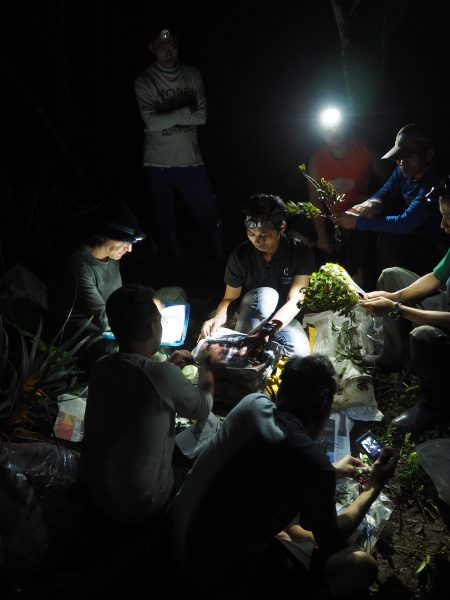
Processing botanical specimens into the night at Mt. Hamiguitan base camp
After three weeks of fieldwork, I traveled to the city of Davao to secure a phytosanitary certificate for the many propagules collected during the expedition. I spent two days cleaning and processing everything and then went to the port for inspection and certification. After clearance, my collections were transported back to the United States for secondary inspection by the USDA. Those materials will now be propagated here at the Garden; many will ultimately find a home in our Greenhouse and Asian Collection.
In parallel to this project, we have been hard at work integrating materials collected from last year’s expedition to Chiapas, Mexico (for more on this project, please see our 2018 Newsletter). Thanks to an anonymous donor, we were able to accomplish much needed tree work in the Mexican/Central American Section, including reduction of unhealthy or overgrown specimens; this has freed space for new accessions. Eric Schulz (Mexico/Central America Horticulturist) has simultaneously undertaken the monumental project of removing ivy, blackberry, and other invasives from previously undeveloped areas in the lower reaches of this section. This effort exposed a broad slope to which he has been introducing dozens of Chiapan plants expertly cultivated by Susan Malisch (Propagator) in the nursery and carefully tracked in our database by Clare Loughran (Assistant Curator). While the display is young, it will hopefully soon mature into an exciting tapestry of cloud forest flora. When you are next at the Garden, we hope you will explore this area, then enjoy watching it develop in subsequent visits.
Serendipitously, this infusion of tropical montane materials coincides with a major renovation of the Tropical House set to commence in 2020. Thanks to the generosity of the Haldan family, we will be able to transform this aging but beloved tropical plant conservatory. Once refurbishment is complete, the enhanced environment in the Tropical House will set the stage for renovation of the interior plantings. While important legacy plants will be carefully maintained, senescing plants and horticultural bedding materials will be replaced with wild-origin accessions from biodiversity hotspots like Mindanao and Chiapas. In the meantime, Corina Rieder (Greenhouse Horticulturist) is bringing her deep tropical plant expertise to bear on cultivating these materials in our back-of-house collections.
As these and our many other collection, conservation, and research projects unfold, all of us at the Garden take pride in contributing to the documentation and preservation of our global flora. Cultivating biodiversity – and sharing it with our visitors – is at the heart of our mission to further the conservation of plants and promote public understanding and appreciation of this diversity. Please stay tuned for more exciting biodiversity initiatives!
